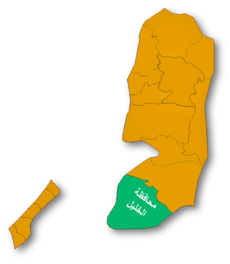Ash-Shuyukh
| Ash-Shuyukh | |
|---|---|
| Other transcription(s) | |
| • Arabic | الشيوخ |
| • Also spelled | Al-Shuyukh (official) |
 Ash-Shuyukh Location of Ash-Shuyukh within Palestine | |
| Coordinates: 31°34′41.22″N 35°08′59.73″E / 31.5781167°N 35.1499250°ECoordinates: 31°34′41.22″N 35°08′59.73″E / 31.5781167°N 35.1499250°E | |
| Governorate | Hebron |
| Government | |
| • Type | Municipality |
| Area | |
| • Jurisdiction | 22,088 dunams (22.1 km2 or 8.5 sq mi) |
| Population (2007) | |
| • Jurisdiction | 8,811 |
| Name meaning | The Sheiks[1] |
Ash-Shuyukh or al-Shuyukh (Arabic: الشيوخ) is a Palestinian town in the Hebron Governorate located 6km northeast of the city of Hebron. According to the Palestinian Central Bureau of Statistics, Ash-Shuyukh had a population of over 8,811 in 2007.[2]
Like the rest of the Hebron area, ash-Shuyukh is an agricultural area. Primary crops include olives, figs, almonds, lentils, peaches and apricots. Olive groves cover 980 dunams while grains and pulses cover 680 dunams. There are about 2,000 sheep and goats in the town raised as livestock.[3]
History
Ottoman era
During the Ottoman era, in 1838, Edward Robinson noted esh-Shiyukh as “a well built village”.[4]
French explorer Victor Guérin visited in 1863, and noted that the village was situated on a high rocky hill. It had 200 inhabitants and a small mosque dedicated to a "Cheikh Ibrahim el-Hedmi."[5]
In 1883, Palestine Exploration Fund's Survey of Western Palestine described it as a "well-built village standing high, and visible from Tekua. There are a few trees round it, and caves. The water supply is from cisterns, and there is a spring to the north."[6]
British Mandate era
In the 1922 census of Palestine conducted by the British Mandate authorities, 'Al Shiukh had a population 792, all Muslims.[7] This had increased at the time of the 1931 census to 925 Muslims, in 180 houses.<ref name="Census1931>Mills, 1932, p. 33</ref>
The first school was established in 1940 by Mohammed Mahmoud Eid.[3]
In 1945 the population of Ash-Shuyukh was 1,240 Arabs, who owned 22,091 dunams of land according to an official land and population survey.[8] 1,713 dunams were plantations and irrigable land, 3,365 for cereals,[9] while 24 dunams were built-up (urban) land.[10]
Post 1967
Another school was built in 2002 and named in honor of a resident killed during the al-Aqsa Intifada.[3]
References
- ↑ Palmer, 1881, p. 408
- ↑ 2007 PCBS Census Palestinian Central Bureau of Statistics. p.118.
- ↑ 3.0 3.1 3.2 Shuyukh Agriculture, Economy and History In Arabic
- ↑ Robinson and Smith, 1841, vol 2, p. 183
- ↑ Guérin, 1869, p. 150
- ↑ Conder and Kitchener, 1883, SWP III, p. 309
- ↑ Barron, 1923, Table V, Sub-district of Hebron, p. 10
- ↑ Government of Palestine, Department of Statistics. Village Statistics, April, 1945. Quoted in Hadawi, 1970, p. 50
- ↑ Government of Palestine, Department of Statistics. Village Statistics, April, 1945. Quoted in Hadawi, 1970, p. 94
- ↑ Government of Palestine, Department of Statistics. Village Statistics, April, 1945. Quoted in Hadawi, 1970, p. 144
Bibliography
- Barron, J. B., ed. (1923). Palestine: Report and General Abstracts of the Census of 1922. Government of Palestine.
- Conder, Claude Reignier; Kitchener, H. H. (1883). The Survey of Western Palestine: Memoirs of the Topography, Orography, Hydrography, and Archaeology 3. London: Committee of the Palestine Exploration Fund.
- Guérin, Victor (1869). Description Géographique Historique et Archéologique de la Palestine (in French). 1: Judee, pt. 3. Paris: L'Imprimerie Nationale.
- Hadawi, Sami (1970). Village Statistics of 1945: A Classification of Land and Area ownership in Palestine. Palestine Liberation Organization Research Center.
- Mills, E., ed. (1932). Census of Palestine 1931. Population of Villages, Towns and Administrative Areas. Jerusalem: Government of Palestine.
- Palmer, E. H. (1881). The Survey of Western Palestine: Arabic and English Name Lists Collected During the Survey by Lieutenants Conder and Kitchener, R. E. Transliterated and Explained by E.H. Palmer. Committee of the Palestine Exploration Fund.
- Robinson, Edward; Smith, Eli (1841). Biblical Researches in Palestine, Mount Sinai and Arabia Petraea: A Journal of Travels in the year 1838 2. Boston: Crocker & Brewster. (p. 185)
External links
- Welcome To al-Shuyukh
- SWP map 21, IAA
- SWP map 21, Wikimedia commons
- Ash Shuyukh Town (Fact Sheet)
- Ash Shuyukh Town Profil
- Ash Shuyukh Town Areal Photol
- The priorities and needs for development in Ash Shuyukh town based on the community and local authorities’ assessment
| ||||||||||||||||||||
